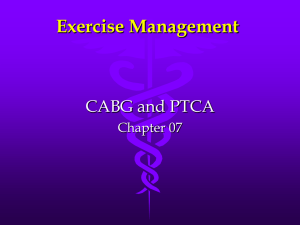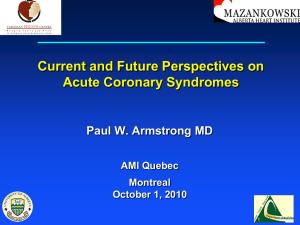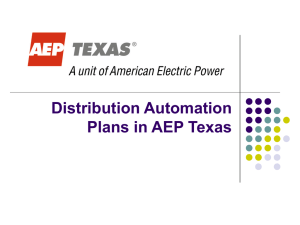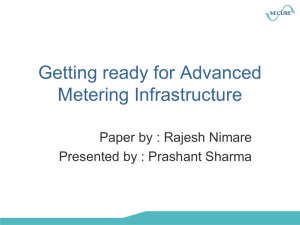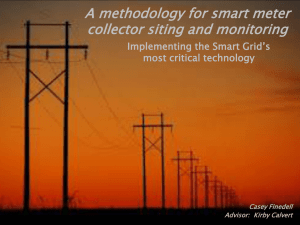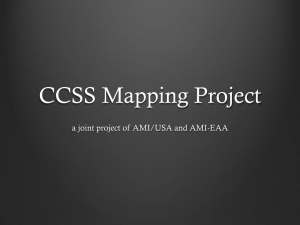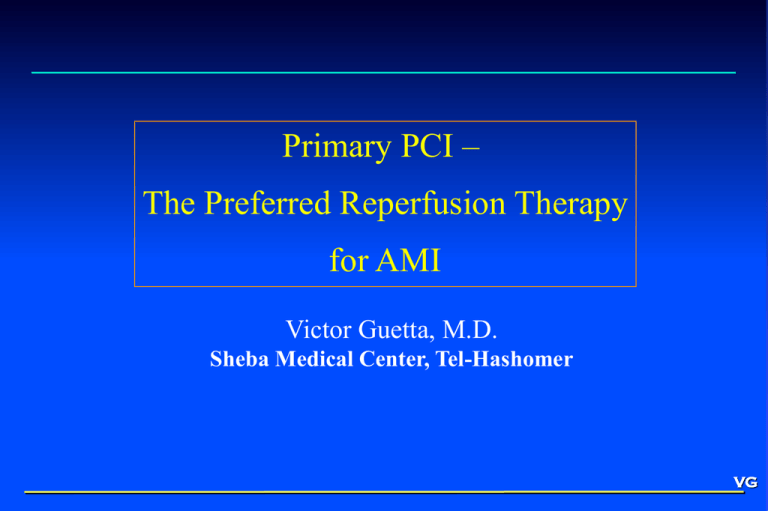
Primary PCI –
The Preferred Reperfusion Therapy
for AMI
Victor Guetta, M.D.
Sheba Medical Center, Tel-Hashomer
VG
Why does fibrinolysis work?
Restores patency of IRA
Salvages myocardium
Prevents unfavorable remodeling
Diminishes electrical instability
Preserves collateral potential
Universally available
VG
Early mortality in AMI
10
9
8
7
6
% 5
4
3
2
1
0
8.8
7
3.7
TIMI 0/1
TIMI 2
TIMI 3
Anderson, AJC, 1996
VG
Redefining the Standard
of Acute Angiography
Meta-analysis of 60-minute angiography
12 trials
1989–1998
1613 patients
SK, r-PA and t-PA
Weighted pooled analysis with 95%
confidence intervals
VG
Redefining the Standard
of Acute Angiography
100%
60 minutes
90 minutes
75%
61%
57%
45%
50%
22%
51%
31%
*
25%
0%
SK
*GUSTO-I angio at 90 minutes
t-PA
r-PA
VG
Redefining the Standard
of Acute Angiography
100%
100%
GUSTO-I
90-min
60-min
23%
75%
Meta-analysis
75%
23%
54%
50%
45%
50%
31%
25%
25%
22%
p < 0.001
0%
0%
SK
t-PA
—NEJM 1993
SK
t-PA
VG
Intracranial Hemorrhage
Thrombolytic therapy induces a relatively high
rate of intracerebral hemorrhage:
1 in 100 to 200 treated patients (~0.7%)
VG
Procoagulant Effects of Thrombolytic Therapy
Fibrin-Thrombin
Platelets
Fibrin-Thrombin
Fibrinolytic
Thrombin begets
thrombin
Resistance to
fibrinolysis
PAI-1
Thrombin increases
platelet aggregation
Platelets
PAI-1
No response to fibrinolytic
VG
Adapted with permission from Topol EJ. Circulation. 1998;97:211-218.
Combination therapy in AMI
Completed studies
On-going studies
TIMI 14
FASTER
SPEED
ENTIRE
INTRO-AMI
INTEGRITI
GUSTO V AMI
ASSENT III
VG
Breaking the ceiling of fibrinolysis
Combination fibrin and platelet lysis has been
shown to enhance arterial patency in AMI
180/90/1.33
VG
GUSTO V
5.91%
5.62%
mortality (%)
6
OR=0.95 [0.83–1.08]
p=0.45
4
2
reteplase (n=8260)
abciximab+reteplase (n=8328)
0
0
5
10
15
days
20
25
30
VG
Why does fibrinolysis not work?
Minimal thrombus in 15%-25%
Reocclusion
Platelet activation
Thrombin
Vasomotor instability
Resistance to lysis - time and composition
Does not alleviate flow-limiting fixed
stenoses
Does not restore tissue perfusion in 20%30% (TIMI 0-I)
VG
DESCRIPTION OF THE TRIALS COMPARING PRIMARY PTCA
AND INTRAVENOUS THROMBOLYSIS
VG
Death and nonfatal reinfarction at the end of study period
VG
Mortality at the end of study period
VG
10 trials
2606 patients
74 mins to primary
PTCA
Overview of Primary PTCA versus
Thrombolytic Therapy
Relative
Reduction
p
# Events
Prevented/1000
Pts Treated
Mortality
32%
0.02
21
Reinfarction
45%
0.04
24
IC Bleed
91%
< 0.001
10
—Weaver, JAMA 1997
VG
Reperfusion therapy for AMI
30-d outcome
Weaver,JAMA 1997;278:2093
VG
Acute MI
PTCA vs Lysis – 6 Month
Mortality (% )
20
15
Thrombolysis
PTCA
24% RRR
10
8.2%
6.2%
5
p=0.04
0
00
11 RCTs (2725 patients)
2
4
Months
Months from
from Randomization
Randomization
6
PCAT Collaborative Group, 2001
VG
Acute MI
PTCA vs Lysis – 6 Month
Death + MI (% )
20
15
Thrombolysis
PTCA
16.1%
37% RRR
10.2%
10
5
p<0.0001
0
0
11 RCTs (2725 patients)
2
4
Months from Randomization
6
PCAT Collaborative Group, 2001
VG
Acute MI
PTCA vs Lysis – 6 Month
Subgroups
n PTCA (%)
Treatment Delay (mins)**
< 35
724
4.7
35-55
1152
7.9
> 55
733
8.3
Site Volume ‡
Low
1533
8.7
Medium
601
5.8
High
501
3.6
Lytic (%)
15.7
12.5
12.1
p = 0.06
12.7
14.0
13.5
p = 0.03
** average time difference between commencing
thrombolytic therapy and performing first balloon
inflation at an individual site level.
‡ Site volume on-study only, classified by number
of patients randomized to PTCA per site per year:
Low = < 15 patients/site year
Medium = 15-30 patients/site/year
High = > 30 patients/site/year
11 RCTs (2725 patients)
Relative Risk (95% Cl)
0.1
0.2
0.5
1.0
Favours PTCA
2.0
5.0
10.0
Favours Lytic
PCAT Collaborative Group, 2001
VG
Acute MI
PTCA vs Lysis – 6 Month
Mortality
In-hospital
30 days
6 months
Re-MI
In-hospital
30 days
6 months
Death + Re-MI
In-hospital
30 days
6 months
Total Stroke
In-hospital
30 days
PTCA (%)
Lytic (%)
4.0
4.3
6.2
6.3
6.9
8.2
2.5
3.2
4.8
6.4
7.6
9.8
6.1
7.0
10.2
11.7
12.9
16.1
0.22
0.66
1.45
1.88
Relative Risk (95% Cl)
0.02
11 RCTs (2725 patients)
0.05 0.1
0.1 0.2
0.2 0.5
0.5 1.0
1.0 2.0
2.0 5.0
5.0 10.0
10.0
Favours PTCA
Favours Lytic
PCAT Collaborative Group, 2001VG
Acute MI
PTCA vs Lysis – 6 Month
Subgroups
Age
< 60
60-70
> 70
Sex
Male
Female
Diabetes
Yes
No
Prior MI
Yes
No
MI location
Anterior
Non-anterior
n
PTCA (%)
Lytic (%)
1178
852
605
4.3
6.3
13.3
8.2
12.8
23.6
2043
591
5.7
11.7
12.2
16.4
367
2151
9.2
6.5
19.3
11.8
383
2250
9.7
6.6
22.7
11.5
1153
1469
8.2
6.2
14.5
12.0
Relative Risk (95% Cl)
0.1
0.2
0.5
Favours PTCA
11 RCTs (2725 patients)
1.0
2.0
5.0
10.0
Favours Lytic
PCAT Collaborative Group, 2001
VG
Acute MI
PTCA vs Lysis
Subgroups
Pulse rate
n
PTCA (%) Lytic (%)
< 65
65-75
75-85
≥ 85
678
513
536
690
5.3
8.2
6.6
8.2
13.4
9.7
12.9
14.6
< 115
115-130
130-150
≥ 150
595
480
737
612
10.5
5.3
7.8
4.5
17.4
10.3
10.4
14.0
Low
Intermediate
High
1186
758
691
2.9
8.0
13.1
7.2
12.7
24.1
0-<2
2-<4
4-<6
≥ 6 hrs
838
1035
347
265
5.6
8.2
6.0
8.5
11.6
12.6
15.6
21.3
SBP(mmHg)
Risk group
Presentation time
Relative Risk (95% Cl)
0.1
11 RCTs (2725 patients)
0.2
0.5
1.0
2.0
5.0
10.0
Favours PTCA
Favours Lytic
PCAT Collaborative Group, 2001
VG
Advances in reperfusion
Stents
Anti-platelet agents
As adjunct to primary angioplasty
In combination with fibrinolysis
As precursor to facilitated angioplasty
Combination
VG
Stents in primary PCI
VG
Reperfusion in AMI
Schomig, NEJM 2000;343:385
VG
Effective reperfusion in AMI
Schomig, NEJM 2000;343:385
VG
Myocardial salvage index
Time from symptom onset to reperfusion
Schomig, NEJM 2000;343:385
VG
Abciximab in primary angioplasty
30-day death/MI/urgent TVR
P<0.01 for all
VG
CADILLAC
[ Presentation of acute safety / outcome data ]
• No difference between groups in mortality, stroke
• Trend toward fewer reinfarctions in stent pts
• Trend toward less ischemia-driven TVR in stent pts
• No difference between groups in ICH
Stent/A
Stent/P
PTCA/A
PTCA/P
TIMI 3 flow 96.7%
92.1%
95%
94.8%
Rec isch
1.2%
3.9%
1.4%
4%
Bleeding
4.5%
3.5%
5.1%
3.1%
Stone. Oral presentation. AHA 1999.
CADILLAC
MACE at 6 Months
Incidence (%)
20%
19.3%
15%
15.2%
10%
10.9%
10.8%
5%
0%
0
30
60
90
120
150
180
Days to event
PTCA, no abx
PTCA, abx
Stent, no abx
Stent, abx
VG
Stone et al. Circ 2000; 102: II-664
ADM IRAL and CADILLAC
Stone et al. Circ 2000; 102: II-664,
Barragan et al Circ 2000; 102: II-662
TIMI 3 Flow
Incidence (%)
100
87.6
93.8 96.1
93.1
75
p = NS
p = 0.04
50
p = NS
20.3 23.8
p = 0.01
25
16.8
5.4
0
Baseline
Final
ADMIRAL
Stent, No Abx
Baseline
Final
CADILLAC
Stent, Abx
VG
ADM IRAL and CADILLAC
Stone et al. Circ 2000; 102: II-664,
Barragan et al Circ 2000; 102: II-662
6 Month Mortality
10
Incidence (%)
7.3
5
3.5
3.3
3.0
55%
14%
ADMIRAL
CADILLAC
0
No Abx
Abx
VG
ADMIRAL vs CADILLAC
ADMIRAL (n=300) CADILLAC (n=2082)
AMI < 12 hrs
AMI < 12 hrs
Double Blind
Yes
No
Pre-PCI Abx?
>25%
High risk anatomy not
excluded
(Stents in 85%)
Patient Population
Clinical High Risk
Yes
No (per protocol)
High risk anatomy
excluded
(Stents in 99.5%)
No
Killip IV
(Mortality > 80%)
8%
Excluded from Trial
TIMI 3 Flow at
Baseline (Pre-Abx)
5.6% (Placebo Arm)
22% (Average)
11%
2%
Angiographic
Exclusion
Prior CABG
VG
Primary Stenting With or Without Abciximab
P=0.024
20
18.1
15
10.4
10
5
0
n=72
n=80
0.8
80
P=0.007
P=0.003
70
global LVEF (%)
25
D wall motion index (SD/CHORD)
D peak flow velocity (cm/s)
Cardiac Function Parameters at 14 Days
0.6
0.44
0.4
0.2
0.15
62
56
60
50
40
30
20
10
0
0
n=72
no abciximab
n=79
n=72
n=79
abciximab
VG
Neumann FJ. Circulation.
1998; 98:2695-2701.
Meta-analysis of abciximab benefit in AMI
A
P
684 685
0.64
30d Death
2.8%
P=0.14
4.2%
0.57
30d D/MI
4.2%
P=0.02
7.2%
0.61
6m Death
4.2%
P=0.04
6.7%
0.57
6m D/MI
7.0%
P=0.003
11.7%
0
1
2
Khot, ACC 2001
VG
Facilitated PCI
PCI soon after pharmacotherapy,
with or without persistent ischemia
VG
SPEED-Facilitated PCI
Freedom from D/MI/UR
MACE at 30 days
Hermann, JACC 2000; 36:1489
VG
Arterial patency before PCI
P<0.0001
P=0.02
Brodie, AJC 2000;85:13
VG
SPEED - Facilitated PCI
N=99
N=195
Hermann, JACC 2000; 36:1489
VG
Evaluation of Myocardial Perfusion
1. ST Resolution:
Schröder JACC 26: 1657,1995
Complete (>70%) Partial (30-70%) None (<
30%)
2. TIMI Myocardial Perfusion Grade (MPG)
TMP Grade 0
No or
minimal blush
TMP Grade 1
Stain present.
Blush persists on
next injection
CM Gibson Circulation 1999
TMP Grade 2
Dye strongly
persistent at end
of washout. Gone
by next injection
TMP Grade 3
Normal ground
glass appearance
of blush. Dye
mildly persistent
at end of washout
VG
Microvascular obstruction
Fibrinolysis/PCI
MVO
Platelets
Plaque
TIMI 3 flow
ST elevation
High cTFC
MCO defect
MRI defect
VG
Tissue reperfusion after fibrinolysis
TMP and 30-day mortality
Gibson, Circulation 2000
VG
“A union in reperfusion”
…”Open vasculature hypothesis” is now a
more appropriate term than “open artery
hypothesis”…It would be logical to offer
the best of the two complementary
strategies….
Gibson, JACC 2000;36:1497
VG
Preventing Distal Embolization
34 y.o. female
presenting with
acute anterior MI
less than 2 hours
from symptoms
onset
VG
Preventing Distal Embolization
Give ASA and Heparin
(ACT 200-250 sec)
Start GP IIb/IIIa
inhibitors
VG
Preventing Distal Embolization
Use X-Sizer or Insert
embolic protective
device
Check the flow
VG
Preventing Distal Embolization
Treat the artery –
Direct stenting if
possible
VG
Preventing Distal Embolization
Final result
VG
New paradigm of reperfusion
Improves speed and quality of reperfusion
Prevents and attenuates consequences of
distal embolization of plaque and
thrombus
Facilitates immediate revascularization
Prevents reocclusion and reinfarction
Do Facilitated Primary PCI !!
VG
יש לך אוטם שריר הלב ,האם תרצה צנתור או טיפול טרומבוליטי ?
STK
ICH
VG

